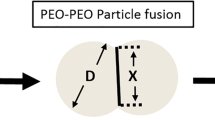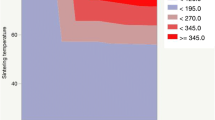Abstract
The in vitro degradation rate of polyanhydride (poly(sebacic acid), diacetoxy terminated), also known as PSADT, was investigated. PSADT tablets with a circular cross-section were formed using a compression molding device, and then immersed into phosphate buffer saline (PBS) for in vitro degradation experiments. The mechanisms of degradation and the degradation rate were characterized by the change in molecular weight and reduction in specimen mass. In addition, the effects of processing temperature and the geometry of the formed PSADT tablets on the rate of degradation were studied. The surface morphology at different degradation times was observed by scanning electron microscopy (SEM). The experimental results showed that PSADT exhibited surface erosion due to the fact that near zero-order degradation kinetics was observed during its degradation process. Moreover, it is found that the geometry of tablets played an important role on the rate of degradation, while the processing temperature had no significant effect on the PSADT degradation rate.
Similar content being viewed by others
References
Ma PX, Langer R. Fabrication of Biodegradable Polymer Foams for Cell Transplantation and Tissue Engineering [J]. Tissue Engineering Methods and Protocols, 1999, 18(Part I): 47–56
Lendlein A, Lange R. Biodegradable, Elastic Shape-memory Polymers for Potential Biomedical Applications[J]. Science, 2002, 296: 1 673–1 676
Estelles JM, Vidaurre A, Duenas JMM, Cortazar IC. Physical Characterization of Polycaprolactone Scaffolds[J]. J. Mater. Sci. Mater. Med., 2008, 19: 189–195
Kim K, Yu MK, Zong XH, et al. Control of Degradation Rate and Hydrophilicity in Electrospun Non-woven Poly(D,L-lactide) Nanofiber Scaffolds for Biomedical Applications[J]. Biomaterials, 2003, 24: 4 977–4 985
Derike F, Burkersroda V, Schedl L, et al. Why Degradable Polymer Undergo Surface Erosion or Bulk Erosion[J]. Biomaterials, 2002, 23: 4 221–4 231
Middleton JC, Tipton AJ. Synthetic Biodegradable Polymers as Orthopedic Devices[J]. Biomaterials, 2000, 21: 2 335–2 346
Leong KW, Brott BC, Langer R. Biodegradable Polyanhydrides as Drug Carrier Matrices. Characterization, Degradation and Release Characteristics[J]. J. Biomed. Mater. Res., 1985, 19: 941–955
Lakshmi KDS, Langer R, Laurencin CT. Biodegradation and Elimination of Polyanhydrides[J]. Adv. Drug. Deliv. Rev., 2002, 54: 933–961
Laurencin CT, Norman ME, Elgendy HM, et al. Use of Polyphosphazenes for Skeletal Tissue Regeneration[J]. J Biomed Mater Res., 1993, 27: 963–973
Torres MP, Determan AS, Anderson GL, Mallapragada SK, Narasimhan B. Amphiphilic Polyanhydrides for Protein Stabilization and Release[J]. Biomaterials, 2007, 28: 108–116
Akbari H, Emanuele AD, Attwood D. Effect of Geometry on the Erosion Characteristics of Polyanhydride Matrices[J]. Int J Pharm., 1998, 160: 83–89
Author information
Authors and Affiliations
Corresponding author
Additional information
Funded by the China Scholarship Council and Wisconsin Institute for Discovery(WID), the Scientific Research Staring Foundation, Fujian University of Technology, China (No. GY-Z13028), the Program for New Century Excellent Talents in Fujian Province University (NCETFJ-2010), and the Research Fund for Fujian Provincial University (JK-2010038)
Rights and permissions
About this article
Cite this article
Cui, Z., Peng, Y., Li, K. et al. The degradation rate of polyanhydride (poly(sebacic acid), diacetoxy terminated, PSADT). J. Wuhan Univ. Technol.-Mat. Sci. Edit. 28, 793–797 (2013). https://doi.org/10.1007/s11595-013-0770-x
Received:
Accepted:
Published:
Issue Date:
DOI: https://doi.org/10.1007/s11595-013-0770-x




